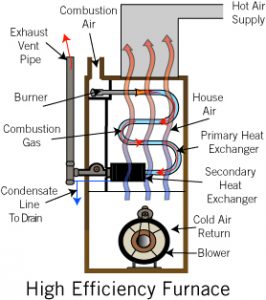 Why does a high efficiency gas furnace need a drain?
Why does a high efficiency gas furnace need a drain?
I recently installed a new, high-efficiency, gas furnace in our home. While reading through the directions I noticed that, unlike the 30 year old furnace we were replacing, this furnace has a drain. Initially I thought this furnace would produce no more than a trickle of water. Our old furnace didn’t produce any water at all. When I turned the furnace on I realized that the furnace was producing a significant amount of water. A quick internet search revealed that a typical high efficiency furnace can produce several gallons of water per day. So why does a high efficiency furnace produce so much more water than an old, low-efficiency furnace?
Water vapor is produced in almost all combustion reactions including burning natural gas. But water vapor is produced whether the combustion occurs in a low or high efficiency furnace. They key point here is that water vapor has significantly more energy than the same amount of liquid water. This is true even at the same temperature. Vapor has a bunch of extra phase energy or latent heat that liquid does not have. In our old, low-efficiency, furnace the water vapor was simply released up the chimney. Unfortunately, that water vapor took a bunch of expensive phase energy with it and left us with a low-efficiency source of thermal energy for our house. Our new furnace can only obtain 96% efficiency if it re-captures a bunch of that phase energy and uses it the warm our house. To accomplish this the furnace condenses most of the water vapor back into liquid before it leaves the furnace. This gives us more thermal energy, saves us money, and leaves me with quite a bit of water to dispose of.